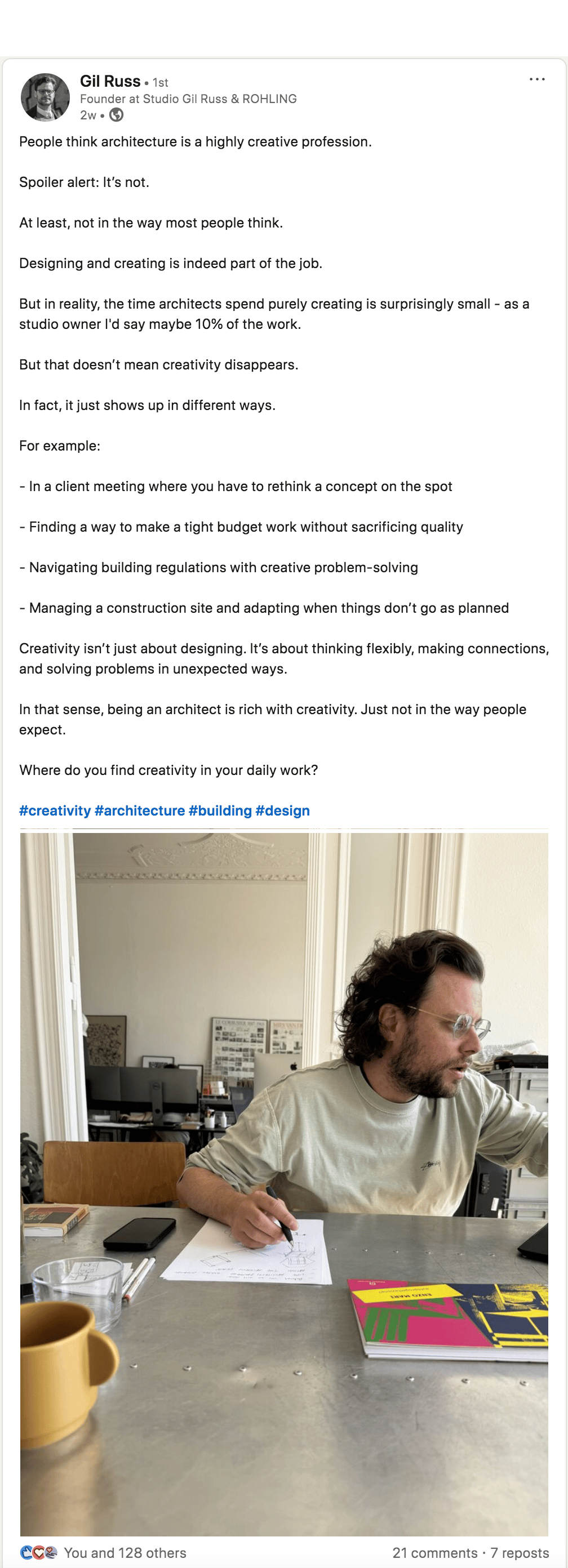My 3 Best-Performing LinkedIn Posts - And Why They Worked
Breaking down the strategies behind posts that got the most visibility and engagement.
BEFORE WE BEGIN:
The following examples are taken from The Visibility Accelerator: my FREE 5-day email course for Architects, Designers, and Furniture and Lighting professionals who want to increase visibility and attract more opportunities on LinkedIn.
Sign up here to get the course
Course content highlights:
How to turn your company page into a B2B magazine.
Why your personal profile is your biggest authority-building weapon.
The secret to writing engaging posts (plus plug-and-play frameworks).
Networking strategies for organic growth and visibility.
Hope you enjoy!
Example #1: A Controversial Opinion
Controversial Opinion piece posts on LinkedIn are key to attracting attention.
They allow you to showcase your expertise, insights, and unique perspectives, which help you distinguish yourself from your industry peers.
Opinion pieces, and slightly controversial opinion pieces, challenge conventional thinking - something which makes you stand out.
Here is a post which I ghostwrote for one of my clients, Gil Russ, founder of Studio Gil Russ Architects:
Strengths of the post
I believe the key strength of this post is that it challenges the commonly held belief that architects sit around drawing all day.
The post begins like this:
"People think architecture is a highly creative profession.
Spoiler alert: It’s not."
The reader is immediately 'hooked' to find out more. So they feel compelled to click 'more' to see the rest of the post.
Then, they're surprised by a counter argument. Gil goes on to say that the job of an architect is to be creative in ways that people least expect, for example, in mundane day to day work situations.
By the end of the post, I make the argument that "being an architect is rich with creativity. Just not in the way people expect".
The post resonated well with audiences, especially architects. It compelled countless people to comment and repost.
The post also brought in an influx of around 200 new connections and followers, which is exactly why we post on LinkedIn.
With repeated exposure to posts, these followers and connections may, one day, become clients.
On LinkedIn, it’s all about being visible and staying top of mind.
Example #2: Process Breakdown
Sharing knowledge, processes and skills is something that you should be doing - especially if you are looking to position yourself as a thought leader.
Often, this means breaking down the way you work, and showing how certain approaches or processes might have led to results.
This next example is another post which I ghost wrote for one of my clients, industrial designer Studio Aldo Deli:
Strengths of the post
Aldo and his team wanted to showcase a prototype of a chair that they’d designed in the hope of finding a manufacturer interested in producing the chair.
Their first post about the chair, which was written by Aldo himself, didn’t perform as well as expected. The text focused on the features of the chair.
Instead, my rewritten version doesn't actually focus on the chair itself.
The narrative focuses upon the unsung heroes of the furniture industry - the talented craftsmen who translate the ideas of designers into reality.
As a result, the post resonated with a wide array of designers and industry specialists, and culminated in Aldo drawing attention from manufacturers regarding production of the chair.
For me, this is a key example of selling without selling. Narratives are memorable. Product features are not.
Example #3: Newsjacking
Newsjacking is a cheeky strategy. It involves capitalising on current news or trending topics to draw attention to your own brand, product, or message.
The idea is to inject your message into a breaking story or hot topic while the news is still relevant, allowing you to jump on the buzz surrounding the event.
This is an example of newsjacking which I wrote for my own personal LinkedIn profile.
The post takes advantage of the immediate news surrounding the IMM trade show cancellation, ensuring high relevance. It taps into a topic that’s already on the radar of industry professionals.
Strengths of the Post
The post helps readers understand that the trade show’s cancellation isn’t an isolated event - but part of a larger market shift. This adds depth and makes the news more impactful.
The post highlights the implications for furniture trade shows in the long run. This encourages engagement and invites others to share their thoughts or insights.
I don’t just report on the news - I propose an alternative by referencing new trade show formats like 3daysofdesign and Fuorisalone.it.
By suggesting Berlin could host a new design festival, the post ties the broader issue to a local opportunity, making it feel more actionable and specific to the community.
This engages the audience further and gives them an actionable way to interact, while subtly positioning myself as someone looking to drive change.
If you work in the fields of architecture and design, and want to get more tips like this about writing engaging LinkedIn content, sign up for my free 5 day email course HERE
Want to work with me directly? Get in touch: patrick@ten-letters.com






